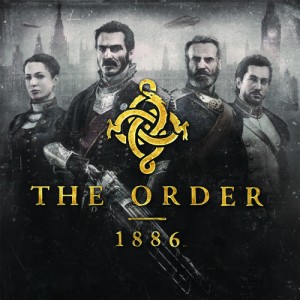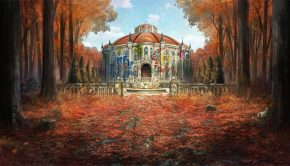The Order -1886- Original Game Soundtrack
 |
Album Title: The Order -1886- Original Game Soundtrack |
| Record Label: Sony Clalssical |
|
| Catalog No.: MOVATM030 |
|
| Release Date: April 6, 2015 |
|
| Purchase: Download at Amazon |
Overview
The much-anticipated The Order: 1886 was scored by two-time British Academy Award-winning composer Jason Graves, who has made a splash in the soundtrack industry in a relatively short span of time through his works for television, films, and most recently video games. Perhaps most well known for his work with the Dead Space trilogy, Graves uses his classical background to create a string-saturated score to Santa Monica’s and Ready at Dawn’s The Order: 1886, an Arthurian-turned-steampunk game set in a London in which the Knights of the Round Table still live, hunting hybrid beast-men to protect humanity. Graves’ score is a compact one, neatly weaving a few select themes into a tidy hour of strings, male vocals, and low woodwinds.
Body
The first word that comes to mind when listening to 1886 is “bass.” There is no question about the intended weight of the score – any instrument that rises above middle C is meant purely as a background sound either to raise hairs or serve as a faint accompaniment to the melody, which is almost always anchored firmly between C3 and C4. The album opens with “The Knights’ Theme,” co-written by Graves and Austin Wintory, is the first realization of the main theme in the score. There is very little intro, other than a couple of arpeggios in the cello, before a solo cello comes in with the signature melody of 1886, a chromatically somber snippet that would be wandering except for the prompt question-and-answer phrasing that Graves meticulously utilizes as a part of his compositional technique. The resulting piece is dark, twisting, and eerie, but still beautiful, particularly after the first minute of the morose solo ends and the rest of the strings unfold into a full string orchestra of variation. A minute later, the strings are met with a low male chorus, Skyrim-style, and the piece blossoms completely into a harmonious choral symphony, completely devoid of brass. The effect is dark, acoustic, and rich — the full range of orchestral sounds is not wasted on Graves, who concludes “The Knights’ Theme” with a last reminder of a distinctly solo cello.
The third track, “Airborne Pursuit,” uses an approach that Graves brings back frequently in the album, with a torrential slew of strings steadily tattooing out a subdivided ostinato that shifts up and down the scale. Graves heavily favors the frog end of the bow to punctuate each staccato note, and while there is a melody (the same melody that opened the album), it only hints, and never fully reveals itself. The resulting track sounds like an cross between Hans Zimmer and Wojciech Kilar, where the piece is certainly not trying to present any strong melody, but still distances itself as far from ambience as possible. “Agamemnon Rising” takes a step further towards Zimmer (crossed with Newton-Howard – think Batman Begins) with a more static pattern in the strings, each note being repeated a single time, and followed by a directional leap oppositional to the previous leap. Despite the fact that, once again, the melody is teased, the strings take a stronger role in providing a pseudo-melody that satisfies the listener’s need for direction in the piece, and the melody plays the role of a strange harmony or counter-melody while the strings continue their pattern.
For the most part, the strings serve as the melody, harmony, bassline, percussion, and any other role a traditional orchestra might offer. Very occasionally, more traditional percussion takes over – more for sporadic divisions of musical segments and startling string breaks than for an actual maintained rhythm. “Commandeered” is one such example of this percussion, as well as one of the extremely rare moments in which the strings rise well into the treble clef while continuing to take center stage in the piece (with an “Airborne”-like pattern, albeit a few octaves higher). “The Rebellion” also uses more mainstream percussion (instead of string substitutes), but this one is more regulated. Each time it surfaces, at the beginning of short phrases, the bass drum plays the same dotted rhythm (occasionally broken up into smaller subdivisions). The piece begins uncertainly, with a sort of muted melody masking the regularity of the bass, but becomes more resolute about a minute in, through a low string pattern that takes over without ever really taking the form of a melody. The drum at this point becomes more regular and energetic (and catchy), as the strings pause and then continue in their pattern.
“The Knighthood” is a marker piece in the score, interestingly falling right at the Golden Mean, in terms of the timestamp of the piece. Jointly composed by Graves alongside Banner Saga‘s Austin Wintory, “The Knighthood” takes the main theme and reworks it into a whole piece again; so far, the album as not featured the melody of “The Knights’ Theme” as prominently as it did in the original piece. The music begins with an extensive choral work, all male vocals, and nearly sacramental in nature. The track shifts from ecclesiastical to thematically 1886 as first a cello, and then a full set of strings, begins the main melody. The choir does not completely disappear but instead fades into the background as the strings work that now-familiar melody.
One of my favorite — more subtle — glimpses of the main theme is in the following track, “The Edge of Sanity,” which doubles as one of the unusually treble-oriented pieces. While the theme is still firmly wedged in the alto range, the accompanying strings and upper octaves of the melody brush the middle ranges of a violin. That particular range returns in “The Scourge,” which brings a distinctly mix of ranges, and perhaps is one of the most firmly soprano pieces in the album. Again, the main melody is still an alto-range, “The Scourge” sees a violin pattern of delightfully dissonant staccato notes maintain an anchor in the upper octaves while the lower strings and male vocals continue their usual eighth notes and rumblings (respectively). There is a pattern to the upper strings, but it goes from a particular, unusual rhythm to quarter notes to shift the piece from startled to driving.
The album ends the way the listener might expect. After beginning with a main theme, incorporating the theme into various settings, rehashing the theme alongside some battle music, it closes with two meditations on themes from the album. “Last Man Standing” opens slowly, with a mournful set of strings that swells and gives way to an a capella male choral moment. The piece essentially pauses while the vocals sing their (relatively aimless) piece, and then the chorals, in turn, give way to a series of individual string lines playing what is at first some skeletal accompaniment before revealing itself to be yet another nod to the main theme of the piece. The album then closes with “Sir Galahad,” opening the same way “Last Man Standing” ended: with some solo, wandering strings. “Sir Galahad” is a musical answer to the question that “The Knight’s Theme” raises — while using the same basic chordal structure, it is far less ominous than the theme, avoiding the morose half-steps and accidentals, instead taking a whole-step-based approach. In fact, the second half of the piece seems to shift into a new mode, filled with bright chords and unflinching violins. With twenty seconds left in the piece, the violins play the melody from the first track once, and then fade away.
Summary
The Order: 1886 is strong soundtrack. Graves has done his job with this score — it is not revolutionary, but it is well-done. The theme is solid, Graves works it well into a variety of pieces, both in its raw form and through variations, and almost every piece contributes to the quality of the album as a whole. The music fits the context of the game, and outside of the game, Graves’ work makes for an ethereal listening experience. The strings are beautifully constructed, and while the album may not appeal to those looking for a fast-paced track or one with varied instrumentation, I found 1886 to be a wonderful score particularly for those more interested in the orchestral, thematic, and atmospheric.
Do you agree with the review and score? Let us know in the comments below!
4.5
Posted on May 1, 2015 by Emily McMillan. Last modified on May 2, 2015.














